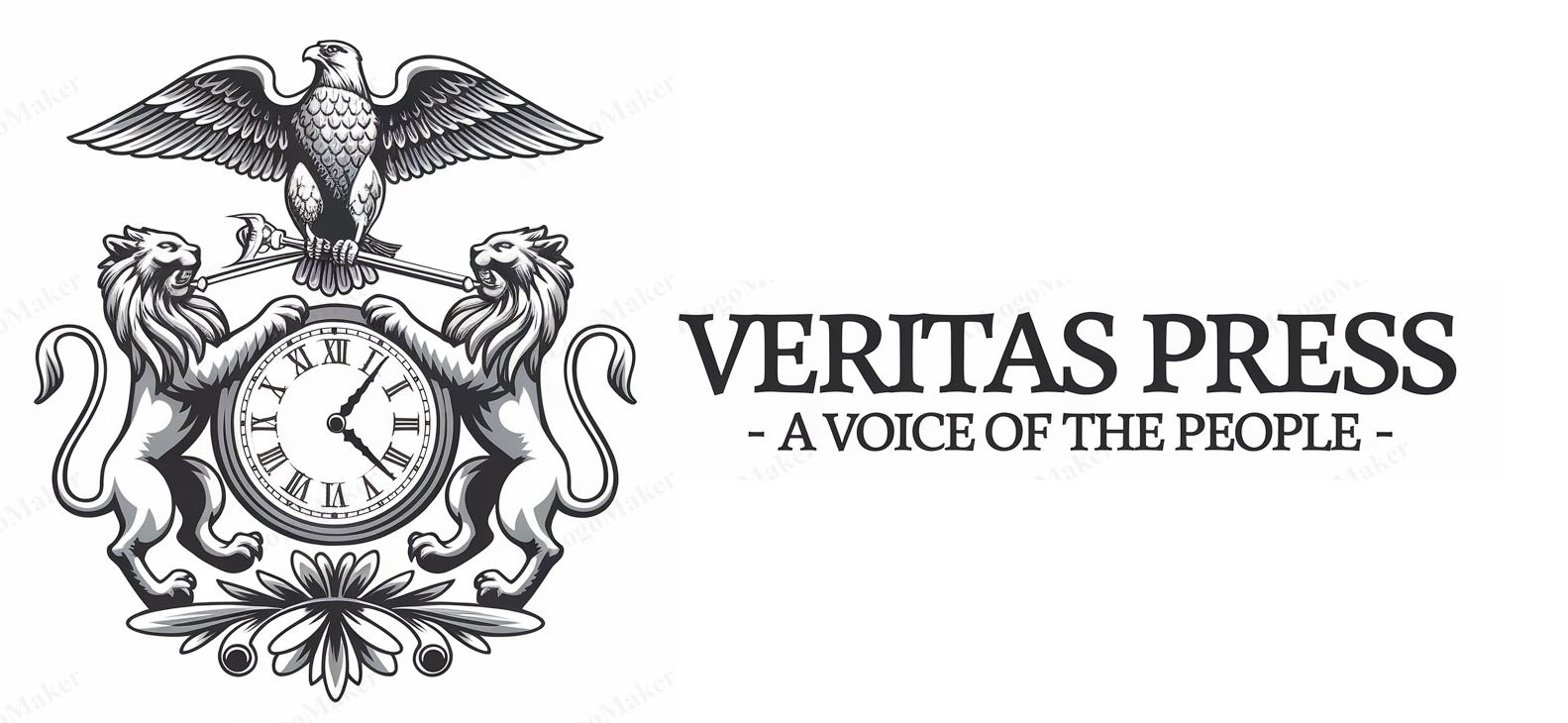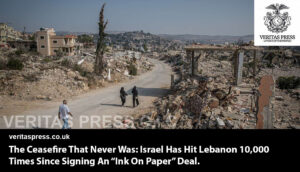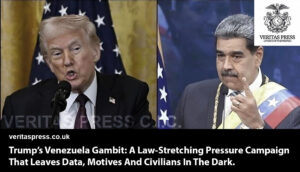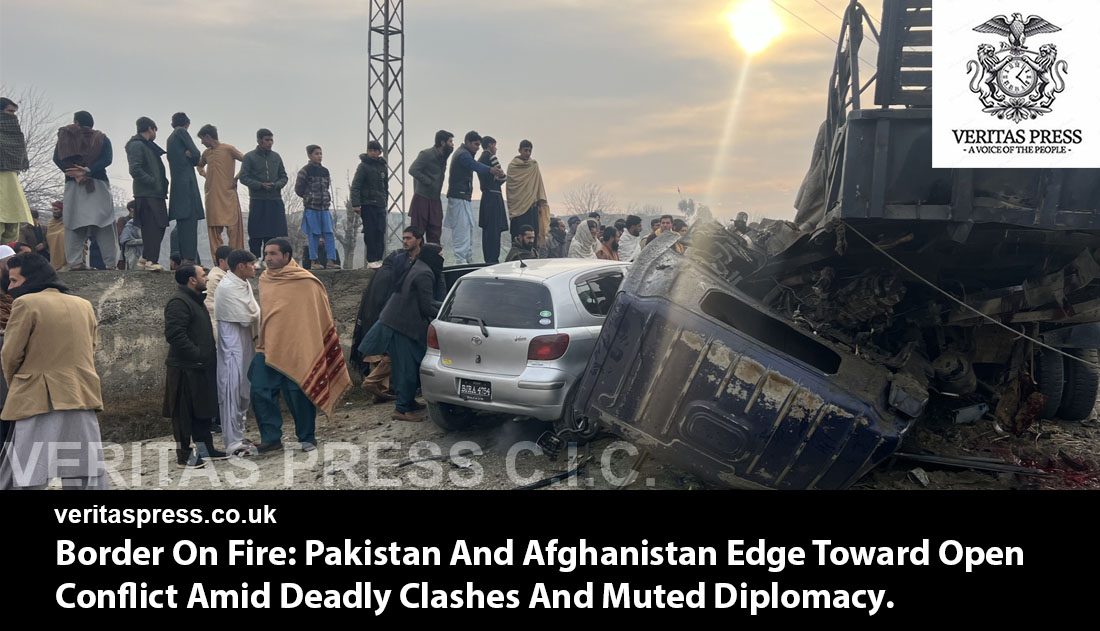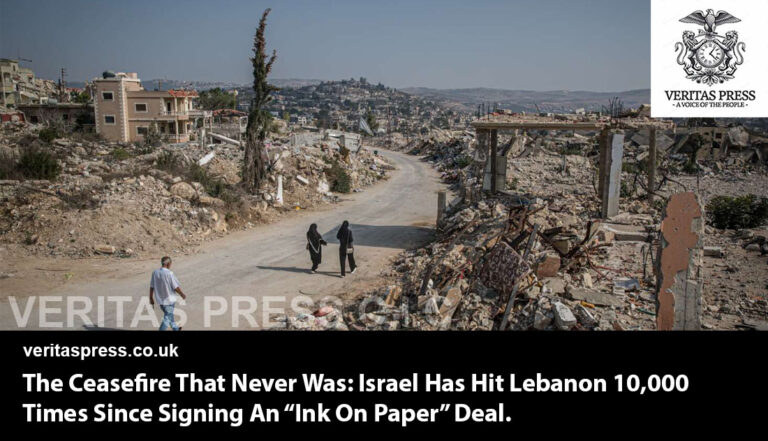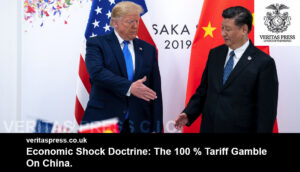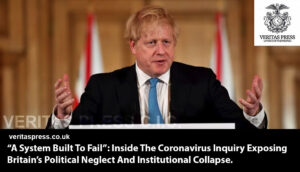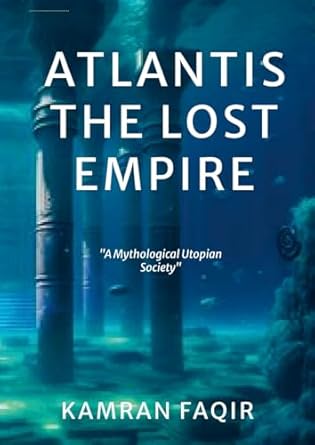President Asif Ali Zardari and Prime Minister Shehbaz Sharif on Sunday asserted there would be “no compromise” on Pakistan’s sovereignty after security forces destroyed Afghanistan’s “several” border posts overnight as they responded to attacks by the Afghan Taliban.
PAKISTAN-AFGHANISTAN – OCTOBER 12, 2025: The Pakistan–Afghanistan frontier has erupted into one of its most serious military confrontations in decades, with both sides trading heavy fire, issuing contradictory casualty claims, and shutting down key border crossings amid a war of accusations that threatens to ignite a regional crisis.
According to Afghan officials, Taliban-led forces killed 58 Pakistani soldiers and seized 25 military outposts during “overnight retaliatory operations” along multiple border points. The Pakistani military, in turn, claims to have captured 19 Afghan border posts, destroyed several Taliban fortifications, and inflicted “heavy losses” on the other side.
Neither claim can be independently verified. Yet, the scale, speed, and simultaneity of attacks across the frontier, from Kunar and Nangarhar to Chitral, Bajaur, and Kurram, mark a dangerous escalation that has drawn alarm from regional powers and exposed the erosion of fragile trust between two nuclear-armed neighbours locked in overlapping security crises.
A Rapid Escalation Following Mysterious Airstrikes:
The border violence comes just days after Kabul accused Islamabad of launching airstrikes on Afghan territory, including in Kabul itself and Paktika province, targeting what Pakistan described as “terrorist hideouts.” The Taliban administration denounced the strikes as violations of sovereignty, claiming they hit civilian markets and homes.
Islamabad has neither confirmed nor denied carrying out the strikes, maintaining instead that it has a right to respond to cross-border terrorism emanating from Afghan soil. “To safeguard Pakistani lives and properties, what measures need to be taken will be taken,” said Inter-Services Public Relations (ISPR) chief Lt Gen Ahmed Sharif Chaudhry in a press briefing.
For Kabul, however, the strikes were a turning point. Taliban spokesperson Zabihullah Mujahid accused Pakistan’s “security establishment” of deliberately trying to destabilise Afghanistan. “If the opposing side violates Afghanistan’s territory again,” he warned, “our armed forces are ready to defend and respond firmly.”
In a sharp riposte, Pakistan’s Interior Minister Mohsin Naqvi described the firing from Afghan forces as “unprovoked aggression targeting civilians,” calling it “an open breach of international law.”
“Pakistan’s forces are alert,” Naqvi said. “Afghanistan is being answered with stones for bricks.”
The Theatre Of War: Heavy Weapons, Tanks, And Drones.
Both sides are now openly mobilising. Afghanistan’s Defence Ministry, through TOLOnews, reported the deployment of tanks and heavy weapons across key frontier provinces, including Kunar, Nangarhar, and Paktika. Pakistani sources, meanwhile, confirmed the use of artillery, drones, and air resources in retaliatory strikes that allegedly destroyed Taliban camps and militant bases.
State-run Radio Pakistan broadcast videos showing Afghan positions ablaze and soldiers surrendering near Kurram, while Afghan media aired footage of captured Pakistani outposts. Border towns such as Torkham, Angoor Adda, and Kharlachi have been sealed off, choking trade routes vital to Afghanistan’s fragile economy.
Locals report that civilians have begun fleeing from several villages near the Durand Line, fearing a prolonged confrontation. The death toll among non-combatants remains unclear.
The Deep Fault Line: Militancy, Blame, And Denial.
Behind the gunfire lies a deeper and more enduring dispute, one rooted in conflicting security doctrines and competing narratives of militancy.
For Islamabad, the Tehreek-e-Taliban Pakistan (TTP), an umbrella group of Pakistani Taliban militants, is the central threat. Pakistan’s government insists that the TTP operates from sanctuaries inside Afghanistan, carrying out deadly cross-border attacks, including last week’s assault on a police training centre in Dera Ismail Khan that killed six officers and a civilian.
Prime Minister Shehbaz Sharif has accused the Taliban administration of “allowing its land to be used by terrorist elements,” calling the border attacks “provocations.”
“There will be no compromise on Pakistan’s defence,” Sharif said. “Every provocation will be met with a strong and effective response.”
Afghanistan rejects these accusations. Taliban officials insist they have no ties with the TTP, and argue that Pakistan’s domestic security failures are being externalised. Yet analysts and intelligence sources suggest the line between the Afghan Taliban and the Pakistani TTP remains ideologically porous and operationally blurred.
“The TTP owes allegiance to the same movement that rules Kabul,” said a former Pakistani intelligence official speaking anonymously. “For Islamabad, that’s not just a border security issue, it’s an existential one.”
Regional Fallout And The Geopolitical Chessboard:
The violence has reverberated far beyond the border hills. Saudi Arabia, Qatar, and Iran have all urged restraint. Riyadh, which recently inked a mutual defence agreement with Pakistan, called for “dialogue and wisdom” to preserve stability. Doha, a key interlocutor with the Taliban, pressed both sides to “prioritise diplomacy and de-escalation.”
Tehran, wary of instability spilling westward, warned that “stability between the two countries contributes to regional stability.” The Iranian Foreign Ministry’s statement reflects broader fears that unchecked hostilities could ripple into a regional proxy struggle, particularly as India, China, and Gulf states jostle for influence in post-U.S. Afghanistan.
Adding to the intrigue, Afghan Foreign Minister Amir Khan Muttaqi was in New Delhi last week, the Taliban’s first high-level visit to India since 2021, where he publicly condemned Pakistan’s “aggression.” Analysts in Islamabad see the timing as no coincidence, viewing Kabul’s outreach to India as a diplomatic jab amid spiralling tensions with Pakistan.
A Crisis Of Credibility And Control:
As both sides claim victories and deny losses, independent verification remains almost impossible. Reuters and the Associated Press report that neither side’s casualty figures can be corroborated, with civilian witnesses largely inaccessible and telecommunications patchy across the mountainous front.
But what is verifiable is the scale of militarisation: artillery, tanks, and drones are being used along a historically porous border that was once policed by little more than local militias and tribal elders. The escalation risks transforming sporadic skirmishes into a sustained low-intensity war, especially if either side seeks to prove dominance through “punitive strikes.”
At the heart of the crisis lies a crisis of control. Pakistan’s army faces rising domestic attacks by militants while managing economic turmoil and political divisions at home. The Taliban, meanwhile, confronts international isolation, financial collapse, and insurgent threats from Islamic State-Khorasan (ISKP), making confrontation with Pakistan both a diversion and a nationalist rallying cry.
The Human And Strategic Costs:
Behind the rhetoric of “brotherly nations” lies a grim reality: the border communities, from Chaman to Kurram, are paying the price. Trade convoys stand idle, refugee flows risk accelerating, and humanitarian supplies, including wheat and fuel shipments, are frozen.
“Every time the border closes, prices skyrocket,” said a trader in Jalalabad, speaking via phone. “People here have nothing to do with the politics of Kabul or Islamabad, but we are the first to suffer.”
The standoff also jeopardises broader regional connectivity projects, including China’s Belt and Road corridor extensions and the long-planned Central Asia–Pakistan trade routes, both dependent on border stability.
Beyond The Border: Global Implications And Strategic Realignments.
The Pakistan–Afghanistan clashes carry far-reaching consequences that could reshape South Asia’s geopolitical balance and redraw the map of post-war Afghanistan’s alliances.
1. India’s Quiet Calculus:
New Delhi has watched the conflict unfold with deliberate silence, but not disinterest. The Taliban’s outreach to India marks a strategic overture, seeking diplomatic recognition and economic aid while driving a wedge between Pakistan and its former client. For India, an embattled Taliban regime fighting Pakistan could serve as a strategic buffer, limiting Islamabad’s influence over Kabul and reducing the operational space for anti-India groups once sheltered under the Pakistani Taliban umbrella.
“India will not intervene militarily, but it has every incentive to quietly encourage a realignment in Kabul,” said security analyst Ajai Shukla. “A Taliban that feels betrayed by Pakistan opens the door for India to re-enter Afghanistan’s development and intelligence landscape.”
2. China’s Belt and Road in the Crossfire:
Beijing’s China–Pakistan Economic Corridor (CPEC) runs perilously close to areas now under fire. Any prolonged conflict could jeopardise billions in Chinese infrastructure investments and disrupt Beijing’s plans for westward connectivity through Afghanistan to Central Asia and Iran.
China has maintained an official silence, but experts note its unease. “Beijing is caught between its two uneasy partners,” said former diplomat Mushahid Hussain Syed. “It needs Pakistan for CPEC’s stability and the Taliban for security guarantees against Uyghur militants. War between them undermines both.”
3. The U.S. and the Vacuum of Leverage:
Washington’s post-withdrawal disengagement has left it with little leverage over either actor. Yet a renewed Pakistan–Afghanistan conflict risks undoing years of counterterrorism efforts, as militant groups exploit the chaos. U.S. intelligence has already warned that the deteriorating border situation could provide breathing space for ISKP, which remains active across eastern Afghanistan.
A senior Western diplomat in Islamabad described the situation as “a slow-motion collapse of the security order the U.S. spent two decades trying to build.”
4. Iran, Russia, and the Emerging ‘Shadow Axis’:
Tehran has offered mediation, but analysts suggest Iran, along with Russia, may quietly benefit from Pakistan’s distraction. Both countries have sought to expand influence in western Afghanistan, while viewing Pakistan as an extension of U.S. and Saudi security interests. Any protracted crisis along Pakistan’s western border could accelerate regional realignments, with Russia, Iran, and China filling the vacuum of Western diplomacy.
Toward A Dangerous New Normal:
The Pakistan–Afghanistan conflict is no longer a question of isolated skirmishes; it is a test of the post-U.S. regional order. The Taliban’s legitimacy depends on defending sovereignty; Pakistan’s on projecting deterrence. Both are trapped in domestic pressures that make compromise politically costly.
Analysts warn that without immediate international mediation, not just symbolic calls for restraint, the two countries could slip into a protracted confrontation. “We are witnessing the re-militarisation of the Durand Line,” said South Asia analyst Dr. Ayesha Siddiqa. “It’s not just about border posts, it’s about the collapse of trust between two regimes that no longer recognise each other’s security realities.”
As of Sunday evening, the guns have not fallen silent. The skies over Kurram and Nangarhar still echo with shellfire. And between Kabul’s accusations and Islamabad’s denials lies a truth both sides refuse to confront: that this is not merely a border war, but a battle over the future of regional order, legitimacy, and survival.
Conclusion: An Unspoken War For Survival, And Narrative.
What is unfolding along the Durand Line is more than a border skirmish; it is the violent unravelling of two regimes bound by shared insecurity, mutual distrust, and the ghosts of their own past policies. Both Pakistan and the Taliban’s Afghanistan have built their legitimacy on the language of sovereignty, defence, and religion, yet both now find themselves trapped in a cycle of militarisation and manipulation that serves foreign interests more than their own people.
For Pakistan’s military establishment, the confrontation with the Taliban is an ideological and strategic reckoning. Islamabad spent decades nurturing Taliban factions as proxies to secure influence in Afghanistan and counter Indian leverage. Now, those same forces, armed and emboldened by years of U.S. warfare and regional patronage, have turned against the very state that once shielded them. The conflict is, at its core, Pakistan’s confrontation with the consequences of its own regional experiment in controlled instability, one that has long outgrown its control.
For the Taliban regime, the clashes serve as both assertion and distraction. Besieged by international isolation, economic collapse, and growing domestic dissent, the leadership has seized upon confrontation with Pakistan as a nationalist spectacle, a performance of sovereignty that masks deep internal fractures and mounting governance failures. The border has become a theatre of legitimacy, where defiance substitutes for diplomacy and militarism masquerades as strength.
Yet beneath the rhetoric of “retaliation” and “self-defence” lies a larger, more dangerous pattern, one that extends beyond Kabul and Islamabad. Both nations are increasingly being pushed, overtly and covertly, into a proxy war designed and fuelled by foreign actors whose ultimate objective is not security, but destabilisation: to fracture what remains of regional cooperation and to prevent the emergence of a unified Muslim front across South and Central Asia. The sharpening of the Pakistan–Afghanistan divide plays directly into the hands of those global and regional powers who benefit from perpetual fragmentation, who profit when Muslim nations remain divided, embattled, and consumed by internal wars rather than collective strength.
This engineered conflict is not only eroding sovereignty but also manufacturing civil and sectarian discord within both countries. In Pakistan, the border clashes are inflaming ethnic grievances in Pashtun regions long neglected by the state, while fanning anti-Afghan sentiment in urban centres. In Afghanistan, the Taliban’s hardline nationalism and cross-border hostility are deepening internal fissures between ethnic groups and ideological factions. The same external actors stoking interstate confrontation are, in parallel, fueling intrastate polarisation, ensuring that both societies remain fragmented, divided, and easily manipulated.
In this unfolding proxy struggle, both governments have become instruments of larger geopolitical designs, their sovereignty hollowed out by dependence on external funding, arms, and political leverage. Each side’s invocation of “terrorism” and “Indian interference” reveals as much about real security concerns as it does about the foreign narratives being imposed upon them. Neither side allows independent verification; both deny civilian casualties; both cloak their failures in the language of national defence. The result is an information war that hides the human one, where villages are shelled, crossings closed, and refugees once again caught between two collapsing fronts.
What is happening along the Durand Line marks the slow death of the regional order that followed America’s withdrawal from Afghanistan. The U.S., China, India, Russia, and the Gulf states now hover at the edges of this crisis, each pursuing influence, none offering stability. The absence of credible mediation has turned militarism into the only language of diplomacy left.
Unless Pakistan and Afghanistan recognise that they are being drawn into a broader game of engineered chaos, one designed to weaken both states, ignite sectarian divisions, and erode any potential unity among Muslim nations, this conflict will spiral into a self-perpetuating disaster. The two countries are not just fighting over a border; they are being manipulated into fighting over their very future.
If this trajectory continues, the Durand Line will cease to be a border and instead become a wound, an open scar in the geography of the Muslim world, bleeding from both sides while foreign powers quietly collect the dividends of disunity. What began as a clash of sovereignty risks ending as a war of self-erasure, where both states, trapped in narratives of control and vengeance, lose not just territory, but the very possibility of independence they claim to defend.
And as the cannons fall silent only long enough to reload, it is ordinary people who bear the price of this engineered chaos, the border villagers displaced yet again, the traders cut off from livelihoods, the children growing up amid shellfire and propaganda. The humanitarian crisis taking shape across the frontier is not an accident of war, but its intended outcome: to exhaust societies, fracture solidarity, and deepen the despair that keeps the region pliable to external manipulation. In the shadow of the Durand Line, the human cost of this proxy war is becoming the most devastating measure of its success.
